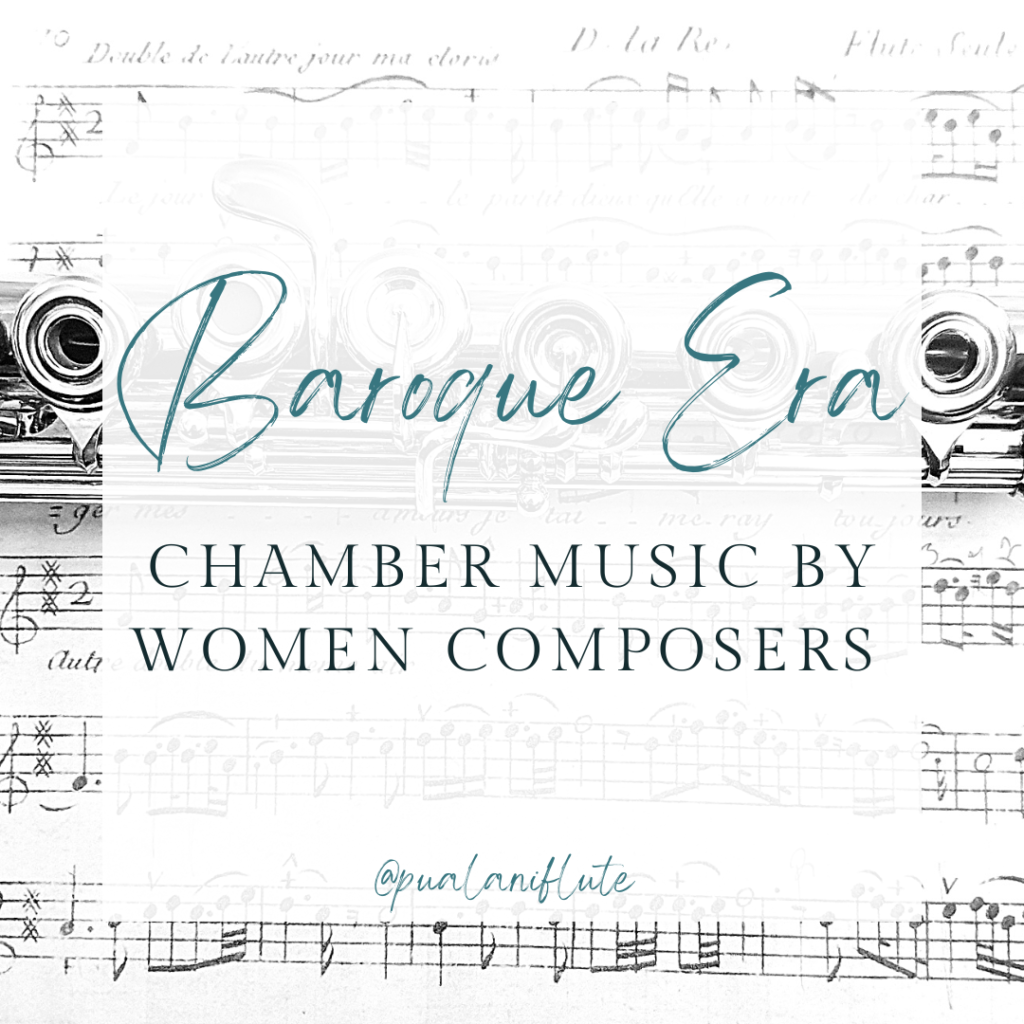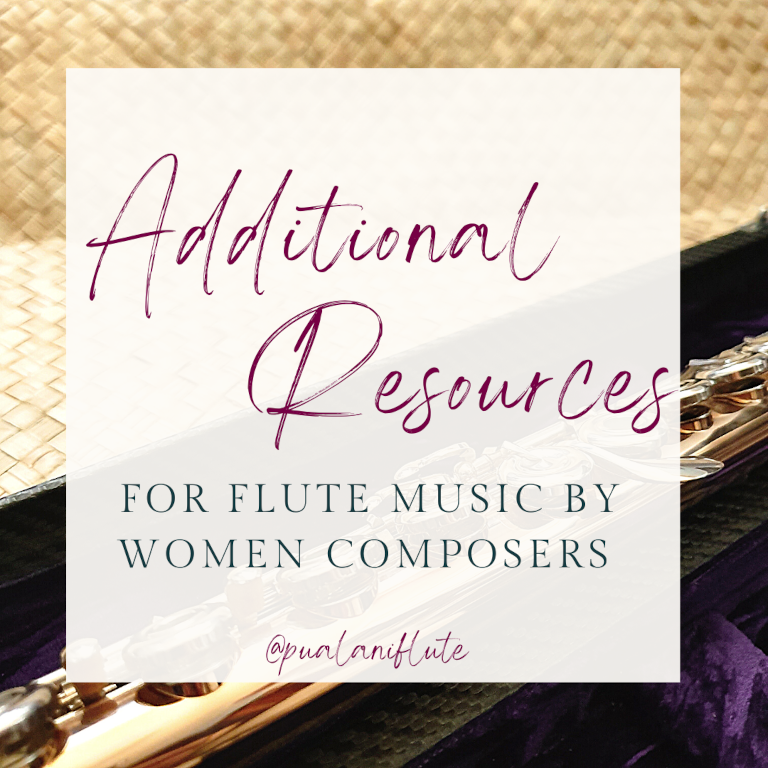In the process of researching flute music by historical women composers, I’ve come across many surprises that I did not expect. One of those was the types of music that I encountered – in school, many of my teachers focused on solo repertoire like sonatas and concerti. And as a result, I expected that a majority of pieces by women composers would take those forms too. However, in the Baroque era, I’ve found that a lot of compositions for flute are actually trio sonatas, or other chamber works for small ensembles.

There may be a few different reasons for that – women did not typically play flute in this era, so maybe it just wasn’t their priority or the instrument they were most familiar with. Maybe chamber ensembles were more appropriate than solo features for the types of social gatherings that 18th century women typically composed for.
Or maybe our cataloging systems are muddying the waters, as it was an acceptable performance practice back then to swap out instruments as needed, but many pieces that can be (and likely were) played on the flute have been categorized only as violin compositions.
Although the Virtuosa Flute Solos database focuses on repertoire for solo flute, I love playing chamber music, and wanted to share the duets and trios that I’ve come across. So without further ado, here are 35 Baroque chamber pieces for small ensembles, featuring the flute!
P.S. – I’ve included links for sheet music in each title below. Many of these pieces are in the public domain; however, the links for those that aren’t are not affiliates or sponsors.
Trio sonatas and chamber music for small ensembles featuring the flute
Anna Bon di Venezia – Divertimenti, Op. 3 (1757)
Anna Bon was a cembalist, singer, and composer from a family of travelling musicians. She studied at the Ospedale della Pietà in Venice while her parents toured the courts of Russian nobility. After her graduation, she joined her parents at the court in Bayreuth, where Wilhelmine von Bayreuth (Frederick the Great’s elder sister) became her patron and mentor.
In 1756, Anna Bon became the first Chamber Music Virtuosa in the service of Margrave Friedrich von Brandenberg-Bayreuth, a flute student of Johann Joachim Quantz. Anna Bon composed six divertimenti for two flutes + continuo in a transitional late Baroque / early Classical style, and also wrote an opus of flute solos with keyboard accompaniment.
Isabella Leonarda – 12 Sonatas, Op. 16 (1683)
Isabella Leonarda was a composer, music teacher, and nun from Novara, Italy. She was one of the most prolific composers of the Baroque era, writing over 200 pieces across a span of 60 years. Isabella primarily composed sacred music, including motets, sacred dialogues, masses, and psalm settings. However, she is also known for publishing the first collection of instrumental sonatas by a woman composer.
These won’t turn up in a search for flute music because they were published as pieces for two violins + continuo – but in this era, instrumentation was more flexible, and the violin parts are within the range of a modern flute. Sonata 12 (or ‘Sonata Duodecima’) is the most popular, but they are all available in the public domain on IMSLP.
Mrs. Philharmonica – 12 Triosonaten (1715)
Mrs. Philharmonica was the pseudonym for an anonymous 18th century English woman composer. As a result, we know nothing else about her – and these are either her only surviving works, or the only ones she published under this name.
These intermediate-level works are composed in a style reminiscent of Corelli, and are published in two sets – book one contains 6 trio sonatas, and 6 divertimenti make up book two. They can be performed by two flutes or violins + continuo (though a few low notes will need to be moved up an octave on flute).
Julie Pinel – Nouveau recueil d’airs sérieux et à boire (1737)
Julie Pinel was a French composer from a family of lutenists employed at the court of Charles de Rohan. She also composed an opera called Appolonius, though the manuscript has been lost.
This collection of arias is her sole surviving work, and includes airs sérieux for flute, voice, and continuo. It’s available as a free download, in the public domain at IMSLP.
Mademoiselle Duval – Passacaille from Les Génies, ou Les caractères de l’Amour (1736)
Mlle Duval was a French composer, dancer, and harpsichordist. We don’t know her first name, and this may have been a stage name – but the commonality of ‘Duval’ as a surname has complicated researchers’ efforts to learn more about her.
This Passacaille comes from Duval’s best-known work, an opera ballet that she composed when she was 18. It ran for 9 performances in October 1736 (during which, she also performed as the harpsichordist). Les Génies was the 2nd opera by a woman composer to be performed at the Paris Opera.
The reduced score is available in the public domain on IMSLP. Although it was originally written for chamber orchestra, the Passacaille can be played with 2 melody instruments (flute, recorder, violin, oboe, etc.) and continuo. It starts on page 106 of the score (or page 113 of the scanned PDF).
Amanda Oosthuizen and Jemima Oosthuizen, ed. – A Musical History Book 1: Duets for Two Flutes
Last but not least, this is an intermediate level duet collection that contains a range of 17th-19th century pieces transcribed for two flutes – including a few vocal works by popular Baroque era women composers. Although these pieces weren’t originally written for flutists, they’re still worth checking out, to get a wider sense of the music women typically composed in this era – a majority of Baroque women composers wrote motets and chamber works for voice + accompaniment.
Pieces in this collection include Lasciatemi qui solo, by Francesca Caccini; Su presti, su presti, by Barbara Strozzi; and Ritournelle, by Elisabeth Jacquet de la Guerre.
Additional Resources
Accompaniment Tracks
A playlist of accompaniment backing tracks for Anna Bon’s flute music, including Divertimenti, Op. 3, Nos. 1 and 2. Videos include scores with both flute parts on-screen. Posted by Gonzalo Ortiz Delgado.
J’te Présente – L’Opéra et ses Zouz
Playlist of short bios of Baroque era women composers (videos are in French, with English captions).
Additional Chamber Music
Check out this blog post for more chamber music featuring the flute, including pieces from the Romantic era and resources for contemporary chamber music!
